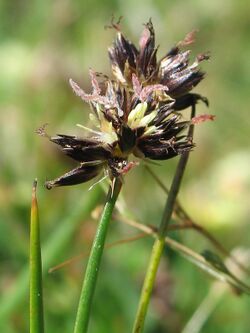Biology:Juncus phaeocephalus
| Juncus phaeocephalus | |
|---|---|

| |
| Juncus phaeocephalus var. phaeocephalus | |
| Scientific classification | |
| Kingdom: | Plantae |
| Clade: | Tracheophytes |
| Clade: | Angiosperms |
| Clade: | Monocots |
| Clade: | Commelinids |
| Order: | Poales |
| Family: | Juncaceae |
| Genus: | Juncus |
| Species: | J. phaeocephalus
|
| Binomial name | |
| Juncus phaeocephalus | |
Juncus phaeocephalus, the brown-headed rush, is native mostly along the coast of California , north to Oregon and Washington (state) .[1] It grows in moist seeps and shallow wet soil.
Distribution
Juncus phaeocephalus is native to the coastlines of California. It is distributed in meadows and borders of swamps and coastal regions from Los Angeles County and Mendocino County to Oregon and Washington (state) .[2]
- Habitat and ecology
Juncus phaeocephalus grows along the coast in sand dunes, marshes and sloughs. Some of them also grow inland in wet grassy meadows, bogs, and along lakes and streams, such as in the Peninsular Ranges and Transverse Ranges of Southern California.[3][4] Its creeping rhizomes can spread across moist soil. This perennial plant can grow in elevations less than 2,200 metres (7,200 ft) high.
Description
Juncus phaeocephalus is a grasslike perennial with stout, creeping rhizomes. It has flattened stems that are two-edged and can grow up to 1.5 feet (0.46 m) tall. Its leaves are shorter than its flowering stems. Flowers have a brownish color and appear in spherical clusters at the tops of the flowering stems. Brown-head Rush may be mistaken for sedges or irises because of its stems and leaves.[5] This plant produces many seeds. These ovoid seeds are about 0.6 mm in size.[6]
Varieties
Juncus phaeocephalus is a variable species in which several subspecific varieties have been characterized mainly on its branching patterns of the inflorescences.
Named varieties include:[7]
- J. phaeocephalus var. phaeocephalus — plants with few, many-flowered heads.
- J. phaeocephalus var. paniculatus— plants with many, few-flowered heads.
- J. phaeocephalus var. glomeratus — plants with many, many-flowered heads.
Poisonous plant
According to the tests made on the plants at the Chemistry Laboratory of the California Department of Food and Agriculture, Juncus phaeocephalus has as much as 30 ppm of hydrocyanic acid present in the plants. Due to its volatile nature, the concentration of this chemical might have been greater before the actual testing was made.
One actual case of hydrocyanic acid poisoning from a common rush occurred in California. In December 1958, two dairy heifers were found dead on a farm land near Petaluma, Sonoma County. The heifers died due to consumption of Juncus phaeocephalus plants.[8] Juncus phaeocephalus grows in plant communities with Verbena spp., Mimulus guttatus, Eleocharis macrostachya and Agrostis densiflora.[9]
References
- ↑ USDA— Juncus phaeocephalus . 2.12.2013
- ↑ Jepson, Willis (1957). A Manual of the Flowering Plants of California. Berkeley and Los Angeles: University of California Press. pp. 1238. ISBN 9780520006065. https://archive.org/details/bub_gb_bffkmpjLa8EC. "A Manual of the Flowering Plants of California."
- ↑ Calflora . 2.12.2013
- ↑ Parikh, Anuja; Nathan Gale (1998). "Vegetation monitoring of created dune swale wetlands, Vandenberg Air Force Base, California". Ecological Restoration 6 (1): 83–93. doi:10.1046/j.1526-100x.1998.06111.x.
- ↑ Todd Keeler-Wolf; Allan A. Schoenherr; Michael G. Barbour (2007). Michael G. Barbour. ed. Terrestrial Vegetation of California (Third ed.). Berkeley, Los Angeles, California: Regents of the University of California. ISBN 978-0-520-24955-4.
- ↑ Bruce G. Baldwin, ed (2012). The Jepson Manual: Vascular Plants of California (Second ed.). Berkeley, California: Regents of the University of California. ISBN 9780520253124.
- ↑ Thomas, John (1961). FLORA of the Santa Cruz Mountains of California. Stanford, California: Stanford University Press. pp. 434. ISBN 9780804718622. https://books.google.com/books?id=jTh8OF-Y9SwC&q=FLORA+of+the+Santa+Cruz+Mountains+of+California.
- ↑ Thomas C. Fuller; Elizabeth McClintock (1986). Advisory Editorial Committee. ed. Poisonous Plants of California. Berkeley, Los Angeles, London: University of California Press. pp. 433. ISBN 9780520055698. https://archive.org/details/bub_gb_0-op0XwlDmQC.
- ↑ Edward Sanford Harrison (1892). History of Santa Cruz County, California. San Francisco, California: Pacific Press Publishing Company. https://archive.org/details/historyofsantacr00harr.
External links
- Jepson Manual treatment for Juncus phaeocephalus
- Calflora database: Juncus phaeocephalus
- Juncus phaeocephalus — U.C. Photo gallery
Wikidata ☰ Q6311892 entry
 |

